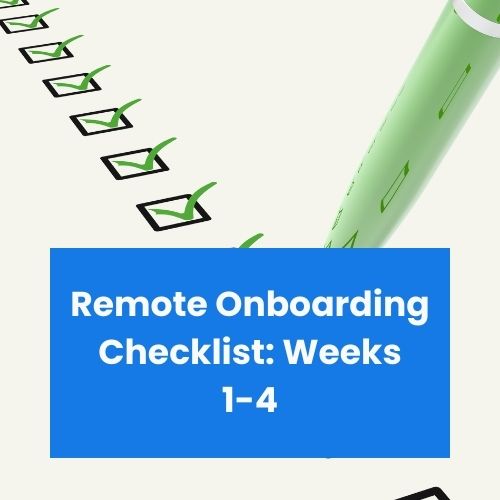Remote Onboarding Checklist: Everything You Need to Do in Weeks 1–4
Remote onboarding doesn’t have to be overwhelming. With the right plan in place, you can give new hires everything they need to hit the ground running (without leaving them lost in a sea of Slack messages, video calls, and forgotten login links).
This checklist breaks down exactly what to do in the first four weeks of a remote employee’s journey. It’s designed to keep things structured and fun, so your new team members feel welcome, capable, and excited from day one. If you’re looking for a broader strategy beyond the week-by-week checklist, check out our remote onboarding best practices.
Week 1: Lay the Foundation
Send equipment and logins in advance: Make sure laptops, headsets, and secure login credentials arrive before the first day.
Kick off with a warm welcome: Set aside time on the first day for a personalized video chat welcome from the manager. Pair it with a welcome kit (swag, handbook, “what to expect” guide).
Assign a buddy or mentor: Give new hires a go-to person for questions, culture tips, and friendly check-ins.
Host orientation sessions: Cover company values, mission, policies, and how to navigate core tools.
Schedule 1:1 introductions: Set up short calls with their manager, teammates, and cross-functional partners.
Why Week 1 matters: This is the impression-setting week. If employees feel supported and connected now, they’ll carry that confidence forward.
Week 2: Build Confidence
Provide role-specific training: Give new hires practical knowledge of workflows, processes, and expectations.
Set clear goals: Share immediate responsibilities and what success looks like in the first 30 days.
Encourage social connection: Organize informal meet-and-greets or fun virtual activities (like one of these virtual onboarding games), especially ones that let new hires connect with each other to make the onboarding process less isolating.
Check in regularly: End of week feedback session to answer questions, clear blockers, and gather first impressions.
Why Week 2 matters: New hires shift from first impressions to a sense of belonging. This week is about building relationships and finding a steady rhythm in their role.
Week 3: Encourage Collaboration
Start meaningful projects: Introduce new hires to smaller, manageable tasks tied to real outcomes.
Facilitate cross-team visibility: Encourage them to shadow or collaborate with different departments.
Reinforce culture: Share stories of company values in action and invite discussion.
Why Week 3 matters: This is where new hires begin to feel like part of the larger organization, not just their immediate team.
Week 4: Reflect and Plan Ahead
Conduct a 30-day review: Celebrate accomplishments, gather feedback, and set new goals.
Offer ongoing learning resources: Share professional development opportunities or skill-building programs.
Encourage peer connections: Pair them with other new hires for coffee chats or networking.
Outline the next 60 days: Give them a roadmap for growth, upcoming responsibilities, and opportunities to contribute.
Why Week 4 matters: Reflection ensures that onboarding is a two-way street. Employees feel valued when their input shapes the process.
What NOT to Do in Remote Onboarding
A strong onboarding plan isn’t just about what you should do. It’s also about avoiding the common pitfalls that make new hires feel overwhelmed or disconnected. Here are a few things to steer clear of:
Don’t overload with information on Day 1. New hires can’t absorb everything at once. Spread out the learning over the first few weeks.
Don’t assume silence means everything is fine. Remote employees may hesitate to speak up, so check in regularly and create safe spaces for questions.
Don’t skip social connection. Jumping straight into tasks without helping people bond with their peers leads to isolation and lower engagement.
Don’t neglect tech setup. If login credentials, software access, or equipment aren’t ready, new hires start their journey feeling frustrated.
Don’t treat onboarding as “one and done.” Onboarding is an ongoing process that lasts weeks (sometimes months), not just a quick orientation session.
Final Thoughts
Remote onboarding isn’t just about handing out laptops and login links. It’s about creating a structured journey where employees feel welcomed, connected, and empowered to succeed. By following this week-by-week checklist, you can turn onboarding from a stressful transition into a launchpad for engagement, productivity, and long-term retention.

